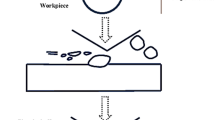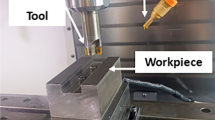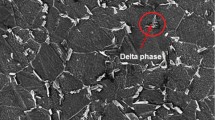Abstract
Flood cooling is a typical cooling strategy used in industry to dissipate the high temperature generated during machining of Inconel 718. The use of flood coolant has risen environmental and health concerns which call for different alternatives. Minimum quaintly lubricant (MQL) has been successfully introduced as an acceptable coolant strategy; however, its potential to dissipate heat is much lower than the one achieved using flood coolant. MQL-nano-cutting fluid is one of the suggested techniques to further improve the performance of MQL particularly when machining difficult-to-cut materials. The main objective of this study is to investigate the effects of two types of nano-cutting fluids on tool performance and chip morphology during turning of Inconel 718. Multi-walled carbon nanotubes (MWCNTs) and aluminum oxide (Al2O3) gamma nanoparticles have been utilized as nano-additives. The novelty here lies on enhancing the MQL heat capacity using different nano-additives-based fluids in order to improve Inconel 718 machinability. In this investigation, both nano-fluids showed better results compared to the tests performed without any nano-additives. Significant changes in modes of tool wear and improvement in the intensity of wear progression have been observed when using nano-fluids. Also, the collected chips have been analyzed to understand the effects of adding nano-additives on the chip morphology. Finally, it has been found that MWCNT nano-fluid has shown better performance than Al2O3 nano-fluid.
Similar content being viewed by others
References
Miller S (1995) Advanced materials mean advanced engines. Interdiscip Sci Rev 20(4):117–129
Davim JP (2011) Machining of hard materials. Springer Science & Business Media Verlag London
Gupta MK, Sood PK, Singh G, Sharma VS (2017) Experimental investigation and optimization on MQL-assisted turning of Inconel-718 super alloy. In: Advanced manufacturing technologies. Springer, Cham, pp 237–248
Wang ZY, Rajurkar KP, Fan J, Lei S, Shin YC, Petrescu G (2003) Hybrid machining of Inconel 718. Int J Mach Tools Manuf 43(13):1391–1396
Alauddin MM, Mazid MA, El Baradi MA, Hashmi MSJ (1998) Cutting forces in the end milling of Inconel 718. J Mater Process Technol 77(1–3):153–159
Dudzinski D, Devillez A, Moufki A, Larrouquere D, Zerrouki V, Vigneau J (2004) A review of developments towards dry and high speed machining of Inconel 718 alloy. Int J Mach Tools Manuf 44(4):439–456
Kadam GS, Pawade RS (2017) Surface integrity and sustainability assessment in high-speed machining of Inconel 718—an eco-friendly green approach. J Clean Prod 147:273–283
Klocke F, Eisenblätter G (1997) Dry cutting. CIRP Ann Manuf Technol 46(2):519–526
Kamata Y, Obikawa T (2007) High speed MQL finish-turning of Inconel 718 with different coated tools. J Mater Process Technol 192:281–286
Cabanettes F, Faverjon P, Sova A, Dumont F, Rech J (2017) MQL machining: from mist generation to tribological behavior of different oils. Int J Adv Manuf Technol 90(1–4):1119–1130
Kaynak Y (2014) Evaluation of machining performance in cryogenic machining of Inconel 718 and comparison with dry and MQL machining. Int J Adv Manuf Technol 72(5–8):919–933
Sadeghi MH, Haddad MJ, Tawakoli T, Emami M (2009) Minimal quantity lubrication-MQL in grinding of Ti–6Al–4V titanium alloy. Int J Adv Manuf Technol 44(5–6):487–500
Kishawy H (2002) An experimental evaluation of cutting temperatures during high speed machining of hardened D2 tool steel
Kishawy H, Li L, El-Wahab A (2006) Prediction of chip flow direction during machining with self-propelled rotary tools. Int J Mach Tools Manuf 46(12):1680–1688
Srikant RR, Rao DN, Subrahmanyam MS, Krishna VP (2009) Applicability of cutting fluids with nanoparticle inclusion as coolants in machining. Proc Inst Mech Eng Part J J Eng Tribol 223(2):221–225
Li B, Li C, Zhang Y, Wang Y, Jia D, Yang M, Zhang N, Wu Q, Han Z, Sun K (2017) Heat transfer performance of MQL grinding with different nanofluids for Ni-based alloys using vegetable oil. J Clean Prod 154:1–11
Ghadimi A, Saidur R, Metselaar H (2011) A review of nanofluid stability properties and characterization in stationary conditions. Int J Heat Mass Transf 54(17):4051–4068
Daungthongsuk W, Wongwises S (2007) A critical review of convective heat transfer of nanofluids. Renew Sust Energ Rev 11(5):797–817
Sharma AK, Tiwari AK, Dixit AR (2015) Progress of nanofluid application in machining: a review. Mater Manuf Process 30(7):813–828
Sharma AK, Tiwari AK, Dixit AR (2016) Effects of minimum quantity lubrication (MQL) in machining processes using conventional and nanofluid based cutting fluids: a comprehensive review. J Clean Prod 127:1–18
Su Y, Gong L, Li B, Liu Z, Chen D (2016) Performance evaluation of nanofluid MQL with vegetable-based oil and ester oil as base fluids in turning. Int J Adv Manuf Technol 83(9–12):2083–2089
Nanomaterials, U.R., US Research Nanomaterials, Inc, The advanced nanomaterials provider. US Research Nanomaterials
Vasu V, Pradeep Kumar Reddy G (2011) Effect of minimum quantity lubrication with Al2O3 nanoparticles on surface roughness, tool wear and temperature dissipation in machining Inconel 600 alloy. Proc Inst Mech Eng Part N J Nanoeng Nanosyst 225(1):3–16
Sinha MK, Madarkar R, Ghosh S, Rao PV (2017) Application of eco-friendly nanofluids during grinding of Inconel 718 through small quantity lubrication. J Clean Prod 141:1359–1375
Zhang Y, Li C, Jia D, Li B, Wang Y, Yang M, Hou Y, Zhang X (2016) Experimental study on the effect of nanoparticle concentration on the lubricating property of nanofluids for MQL grinding of Ni-based alloy. J Mater Process Technol 232:100–115
Pavan RB, Venu Gopal A, Amrita M, Goriparthi BK (2017) Experimental investigation of graphene nanoplatelets–based minimum quantity lubrication in grinding Inconel 718. Proc Inst Mech Eng B J Eng Manuf, 0954405417728311
Phadke M (1998) Quality engineering using design of experiments, quality control, robust design, and the Taguchi method. Wadsworth, Los Angeles
Hwang YJ, Lee JK, Lee CH, Jung YM, Cheong SI, Lee CG et al (2007) Stability and thermal conductivity characteristics of nanofluids. Thermochim Acta 455(1–2):70–74
Huang J, Wang X, Long Q, Wen X, Zhou Y, Li L (2009) Influence of pH on the stability characteristics of nanofluids. In Photonics and optoelectronics, 2009. SOPO 2009. Symposium on (pp. 1-4). IEEE
Vandsburger L (2010) Synthesis and covalent surface modification of carbon nanotubes for preparation of stabilized nanofluid suspensions. Library and Archives Canada= Bibliothèque et Archives Canada
Loos M (2014) Carbon nanotube reinforced composites: CNT polymer science and technology. Elsevier
El-Bestawi MA, El-Wardany TI, Yan D, Tan M (1993) Performance of whisker-reinforced ceramic tools in milling nickel-based superalloy. CIRP Ann-Manuf Technol 42(1):99–102
Bhatt A, Attia H, Vargas R, Thomson V (2010) Wear mechanisms of WC coated and uncoated tools in finish turning of Inconel 718. Tribol Int 43(5–6):1113–1121
Zhu D, Zhang X, Ding H (2013) Tool wear characteristics in machining of nickel-based superalloys. Int J Mach Tools Manuf 64:60–77
Ghaednia H, Jackson RL (2013) The effect of nanoparticles on the real area of contact, friction, and wear. J Tribol 135(4):041603
Winer WO, Peterson MB (1980) Wear control handbook.: American society of mechanical engineers
Sayit E, Aslantas K, Çiçek A (2009) Tool wear mechanism in interrupted cutting conditions. Mater Manuf Process 24(4):476–483
Khandekar S, Sankar MR, Agnihotri V, Ramkumar J (2012) Nano-cutting fluid for enhancement of metal cutting performance. Mater Manuf Process 27(9):963–967
Paul S, Singh AK, Ghosh A (2017) Grinding of Ti-6Al-4V under small quantity cooling lubrication environment using alumina and MWCNT nanofluids. Mater Manuf Process 32(6):608–615
Sayuti M, Sarhan AA, Tanaka T, Hamdi M, Saito Y (2013) Cutting force reduction and surface quality improvement in machining of aerospace duralumin AL-2017-T4 using carbon onion nanolubrication system. Int J Adv Manuf Technol 65(9–12):1493–1500
Stanford M, Lister PM, Morgan C, Kibble KA (2009) Investigation into the use of gaseous and liquid nitrogen as a cutting fluid when turning BS 970-80A15 (En32b) plain carbon steel using WC–Co uncoated tooling. J Mater Process Technol 209(2):961–972
Suresh R, Basavarajappa S, Gaitonde VN, Samuel GL (2012) Machinability investigations on hardened AISI 4340 steel using coated carbide insert. Int J Refract Met Hard Mater 33:75–86
Hong SY, Ding Y, Jeong W-c (2001) Friction and cutting forces in cryogenic machining of Ti–6Al–4V. Int J Mach Tools Manuf 41(15):2271–2285
Jerold BD, Kumar MP (2011) Experimental investigation of turning AISI 1045 steel using cryogenic carbon dioxide as the cutting fluid. J Manuf Process 13(2):113–119
Acknowledgments
The authors acknowledge the support of the Natural Sciences and Engineering Research Council of Canada (NSERC) and the International Scientific Partnership Program ISPP at King Saud University for funding this research work through ISPP no. 0059.
Author information
Authors and Affiliations
Corresponding author
Rights and permissions
About this article
Cite this article
Hegab, H., Umer, U., Soliman, M. et al. Effects of nano-cutting fluids on tool performance and chip morphology during machining Inconel 718. Int J Adv Manuf Technol 96, 3449–3458 (2018). https://doi.org/10.1007/s00170-018-1825-0
Received:
Accepted:
Published:
Issue Date:
DOI: https://doi.org/10.1007/s00170-018-1825-0




